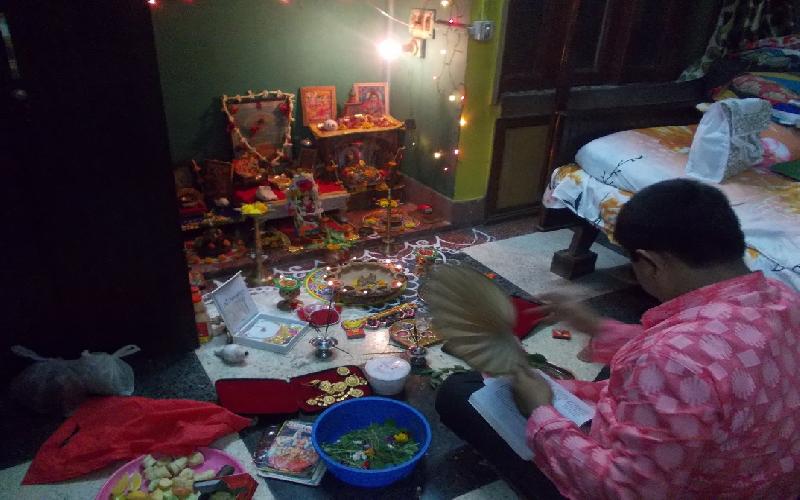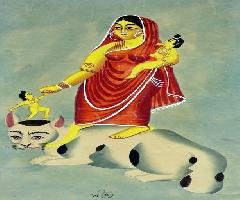Laxmipuja, the worship of Goddess Laxmi is done both during Kojagori Purnima or full moon night, and also on Diwali night. During Diwali night, Laxmipuja is performed on the 3rd day of Diwali.
In India, the Laxmipuja performed on the 3rd day of Diwali is done on a large scale. The preparation for the puja is done over a week. Laxmipuja is the time when the houses are cleaned up. New bed sheets are given on beds, new curtains are given on doors and windows.
Cleaning houses including lights, fans, bathrooms, dining rooms is a good exercise. Cleanliness in next to Godliness.
So during this time of the year, the Hindus by cleaning their premises reduce the existence of germs and bacteria which breed dirt and pollution. After the cleaning is done, alpona and rangoli are given in the houses using colours and rice husk. They get dried in the evening of the Laxmipuja.This is the time of the year, where the festival of lights are also celebrated. While the commodities to be offered to Goddess Laxmi, the Goddess of Wealth is bought, Hindus buy different types of diya at this time.
There is a tradition of giving 14 diyas also called choddo pradip at the time Laxmipuja. The 14 diyas are given on the day of Bhoot Chaturdashi. There was a legendary story that Prince Hima was supposed to die on the 4th day of marriage. His horoscope predicted his death on the 4th day of marriage. His wife knew that Yama was supposed to come to the house in the form of serpent.
Yama came to the house in the form of serpent. The wife of Hima kept all her jewellery before Goddess Laxmi and Lord Kuber, sang bhajans on the night and did not allow her husband to sleep that night. The 14 diyas made of mud and with cotton buds being lid in mustard oil was kept at every part of the house. Yama got diverted by the shine of the gold, silver, bronze, brass jewellery and the 14 diyas and could not kill Hima and returned back. From that time the Hindus believe that on the date of Bhoot Chaturdashi, if the house is cleaned and lit up with 14 diyas and puja performed on the day it can spell off evil spirits. Laxmipuja is the worship of Goddess Laxmi and includes victory of good forces over evil forces.
Coming back to the preparation, these diyas are bought having different shapes. The diyas are made of mud and mustard oil helps the cotton salita to light the diyas. There are different types of diyas bought. The Kulo Pradip is a beautiful diya lit on the night of Laxmipuja, which has the shape of Kulo which is used for winnowing. Whenever newly married Hindu bride enters the groom’s house in India, she is greeted with a kulo. The brides are considered Laxmis of their house.
Another form of Kulo Mombati is used which a king of pancha mombati or five candles created in the form of Kulo. All the five candles are lit and they are kept in front of
the Idol of Goddess Laxmi. The five candles are different colours like red, yellow, orange, white, violet, so look beautiful when lit together.Garlands of marigold flower, hibiscus flower, jasmine flower are offered to Goddess Laxmi. Hindus buy mud idols of Goddess Laxmi and utter mantras to both Goddess Laxmi and Lord Kuber on the night of Laxmipuja. After the puja is over, the idol of Goddess Laxmi is emersed in Holy Ganges.
Hindus make a sweet called naru with coconuts. Sweets are offered to Goddess Laxmi. Fruits in the form of bananas, oranges, guavas, apples, coconuts, cucumbers are offered to Goddess Laxmi.
Before the Laxmipuja, the Hindus eat 14 spinach in the form of lal shakh, kolmi shakh, pui shakh, palang shakh, mulo shakh, methi shakh, note shakh and other spinach. They are eaten on the 2nd day of Diwali.
Goddess Laxmi is also given mangal ghat. On the night of Laxmipuja Goddess Laxmi is offered Sindoor, Haldi or turmeric. Hartuki is given to Goddess Laxmi. Puspanjali in the form of flowers and the leaves of tulsi (basil) and mango leaves and bel leaves are offered where mantras are chanted and the flowers leaves kept at the feet of Goddess Laxmi. Charanamrit is made up of honey, milk, basil leaves and other ingredients.
At the time of arati, the Bhajan Om Jai Laxmi Mata, Maiya Jai Laxmi Mata, Tumko Nisdin Sewat, Har Vishnu Vidhata, is sung. It is a long bhajan sang by renowned Indian singers like Anuradha Paudwal, Lata Mangeshkar, Alka Yagnik, Kavita Krishnamurthy, and others. Hindus sing the bhajan in their own way. The arati is done with ghanta and counch and incense sticks. Also coconut chobra is used in Dhunodani, they are burned with dhuno and used during arati. Even Camphor also called korpur is burned and used during arati. Also panchaparadip is shown to Goddess Laxmi at the time of arati.
The great part of the Laxmipuja is the sharing of Prasad in the form of fruits and sweets to neighbours, friends and relatives. After the puja is over the Hindus come to meet the neighbours and they offer the Prasad.
The festival actually adds brotherhood in the society. If people live together in communities peacefully, there can be more sustained development. Laxmipuja is the festival which integrates people of different caste, creed, language, geographical indications, etc. In the real sense of the term Laxmipuja increases joy, happiness, friendship, prosperity in everyone’s lives.
There is really a fun to work together in the preparation of Laxmipuja by all the family members. In many cases, the family members live in different parts of the country for employment reasons, but at the time of Laxmipuja they unite together and come to the house. In joint family system, Laxmipuja is a festival, where the ties or bondage of the family are strengthened. Where everyone lives together happily society prospers.








